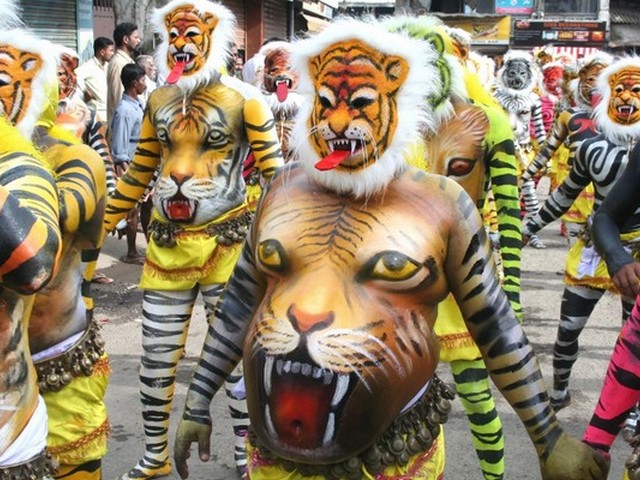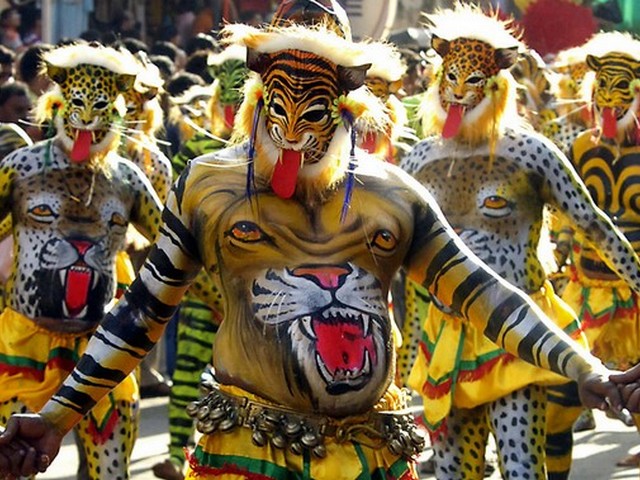Pulikali is one of the most fascinating and fun-filled festivals of Kerala. Pulikali is also known as Kaduvakali is a colorful recreational folk art that is performed by trained artists to entertain people on the occasion of Onam, an annual harvest festival where artists dance wildly and mimic hunting moves to the beat of drums. Pulikali dance is a symbol Onam just like the legend of Mahabali and Pookalam.
ALSO SEE – Onam Festival-Celebrations and the Legend of Mahabali
What is “Pulikali” in Kerala?
Puli means “leopard” and Kali means “Play”. On the fourth day of Onam celebrations (Nalaam Onam), performers painted like tigers and hunters in bright yellow, red, and black dance to the beats of instruments like Udukku and Thakil. The literal meaning of Pulikali is the ‘play of the tigers’ hence the performance revolves around the theme of tiger hunting. Folk art is mainly practiced in the Thrissur district of Kerala. The best place to watch the show is at Swaraj Round, Thrissur on the fourth day of Onam, where Pulikali dance troupes from all over the district assemble to display their skills. The festival attracts thousands of people to Thrissur city.
Planning to Visit Kerala ?- 📍 Top 12 Best Places to Visit in Kerala (with Map)


Pulikali makes use of forms and symbols of nature that finds expression in its bright, bold body painting in yellow and orange and high-energy dance movements. So by fusing man and beast in its artistic language, it flamboyantly celebrates the connection between humans and nature. But one of its grand shows takes place during Onam, the harvest festival signifying the New Year in this region of south India. A quirky procession of vibrantly painted boys and men in the guise of tigers and panthers romp the Swaraj Road of Trichur, on the third day of Onam amid much fanfare. The main theme of the Pulikali-tiger dance is tiger hunting with participants playing the role of tiger and hunter.

Pulikali dance is also known as Kaduvvakali is practiced mostly in the Thrissur and Palghat districts of Kerala and is believed to be a two-hundred-year-old folk dance form and Pulikali performers have faces of lion or tigers painted on their trunks and their legs are pained yellow and is dried by standing under the sun. Pulikali is believed to have been introduced by Maharaja Sakthan Thampuran, the then Maharaja of Cochin is said to have introduced the folk art, who wanted to celebrate Onam with a dance that reflected the wild and macho spirit of the force. Pulikali-tiger dance is a celebration of courage, bravery, and the spirit of battle.

Pulikali dance performances of small scale are common in the villages and towns in Thrissur and Palakkad in Kerala but the grand spectacle is during the fourth day of Onam. Pulikali performers enact scenes such as the tiger preying on an animal, and a tiger being hunted by a hunter. The procession also includes floats from each village. The different troupes vie with each other to make the best floats as well as the best-dressed tigers.
Here is a video of Pulikali Performance in Kerala and if you want to watch this life do visit Thrissur on the fourth day of Onam.
A striking feature of this folk art is the colorful appearance of the performers. A particular combination of tempera powder and varnish or enamel is used to make the paint. Dancers will have to remove the hair from the body, and then, the base coat of paint is applied on them and it takes two to three hours for the paint to dry under the sunlight after which the second coating is applied again to the participants and the entire process takes five to six hours.

Leave a Reply